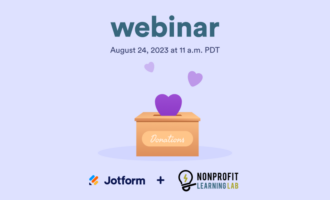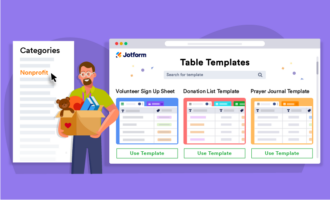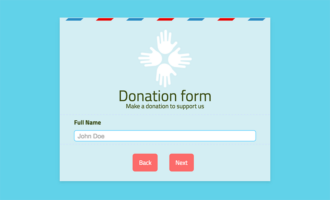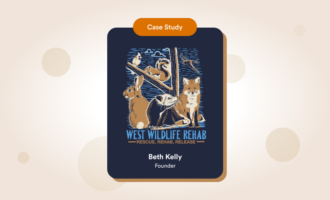Launching a nonprofit organization can be exciting. But the excitement often goes hand in hand with a lot of hard work and challenges in figuring out the best way to achieve your goals.
On the surface, things may seem simple. You’ve probably already identified some sort of need; that’s what often motivates people to start a nonprofit in the first place.
You also may have some experience working to meet that need in various volunteer roles, which feeds into your passion and gives you some idea of what the work looks like. Now, all you have to do is secure funding, formalize your work processes, and start operating as a nonprofit.
Unfortunately, it isn’t that simple. There’s a lot of bureaucracy and red tape involved in launching a nonprofit. You’ll also have to deal with competition. You may not be the only one trying to meet a key need, and that’ll leave you chasing after grants, funding, and volunteer attention with other nonprofits in your region.
In practice, starting a nonprofit begins with building a strong vision for what the organization will do and how it will accomplish it. From there, you can move into formal matters of incorporation and building your organization. Of course, it’s important to understand what a nonprofit is.
What is a nonprofit organization?
A nonprofit is an organization that operates to meet a specific need or further the goals of its members as opposed to generating revenue. There are nuances in terms of the types of nonprofits, which we’ll get into later.
Don’t let the complexity of launching a nonprofit dissuade you from the work you want to do. In many ways, all the boxes you have to check to start your organization can help you refine and define your vision, giving you a stronger foundation to grow over time. The key is to be prepared for the work that’s on the horizon.
That’s what this guide is all about: giving you a deep look at what you’ll need to do to not only get your nonprofit off the ground, but also to create a foundation that will allow for consistent, sustainable progress.
Read on to learn about how to start a nonprofit organization
- Defining your identity. It’s important to understand exactly what your mission and vision are if you want to maintain focus as your organization grows and changes.
- Addressing incorporation. There are a variety of formal procedures you’ll need to go through to achieve nonprofit status.
- Figuring out your structure. Creating bylaws and establishing a working structure is key to maintaining governance and taking full advantage of your opportunities.
- Moving into early operations. Planning for how you want your nonprofit to operate is vital in getting started on the right foot, particularly when it comes to solidifying your presence in the community.
- Supporting day-to-day work. Developing strategies to support your everyday processes is vital in ensuring you can function efficiently once the organization is up and running.
- Setting a pathway for growth. Once your organization is fully functioning, the next step is to create a roadmap for growing your nonprofit.
There’s a lot to think about, but don’t let that hold you back. Do your homework, and you’ll be prepared to start your nonprofit and transform your community.
Defining your identity
Finding success as a nonprofit begins with having a strong identity. Chances are you’ll hear a lot of good, interesting ideas about what you can do at any given time. But how do you determine which ideas are best?
This is where defining your identity is critical. When you have a strong mission and vision, you can test ideas against your core goals and more easily determine the best ways to move forward.
Of course, there’s more to this than the ability to determine the best ideas. A strong idea of what the organization stands for echoes across everything from marketing and fundraising to hiring strategies and incorporation. At the start, you’ll need to determine whether to operate as a nonprofit or a not-for-profit organization.
Nonprofit vs Not-for-profit
These two terms are often used interchangeably. In practice, the difference between nonprofit and not-for-profit is fairly small, but it is integral to how an organization operates.
A nonprofit is generally an organization that doesn’t use any of its fundraised income to pay its staff. That doesn’t mean you can’t pay employees or offer perks to volunteers; you just need to use alternative funding sources so fundraised money is used entirely for the goal of the nonprofit. Not-for-profit entities can use excess fundraised money to pay their staff. Beyond this major point of distinction, the two organization types are extremely similar.
Determining how you want to operate is key at the early stages of the business. This guide focuses on nonprofits, but much of the guidance is valuable to both types of organizations.
In practice, the distinction often boils down to a simple concept: Nonprofit organizations tend to serve either their members or their communities. Not-for-profit status is used for a wider range of purposes. Nonprofits can receive some special tax exemptions if they are religious, charitable, or educational entities. We’ll provide more details on tax status later on.
For more information on the differences between nonprofits and not-for-profits, check out this BizFluent article. Assuming you’ve decided to function as a nonprofit, here are some key issues you’ll want to consider to refine your identity as an organization.
Identify mission, vision, and values
Why are you starting this nonprofit? Your answer to that question may seem like enough to get your organization started, and sometimes it is.
But over time, you’re going to be faced with a variety of difficult decisions about how you want to move forward. Taking the time to craft a mission statement, develop a vision for the organization’s future, and determine your core values can serve as a guiding force as your nonprofit grows and evolves.
Before developing your mission, vision, and values, you should do some serious market research and analysis. You’re probably starting this nonprofit for a specific reason. Maybe you’ve noticed a need in the community or have a cause you’re particularly passionate about. This research lets you gather data and develop concrete ideas that take your initial goals and build them into a basis for your nonprofit.
To analyze your market effectively, you should
- Meet with local community leaders to discuss the needs of your community, including those that may not be entirely relevant to your goals, to better understand what people are looking for from nonprofits in the area
- Identify local and regional influencers you hope to work with and seek out their perspectives on the needs and trends that may impact your nonprofit
- Search for studies and market research from larger nonprofit entities or government agencies to help you see the big picture surrounding the issues you hope to address with your organization
- Engage in volunteer work in a variety of settings and network with other nonprofit leaders to see how different organizations operate and assess the kinds of challenges and opportunities you’ll face
- Identify the primary demographics you expect your organization to interact with and begin developing relationships with relevant individuals so you can get a stronger idea of what they need
Doing this type of deep market research that blends big-picture industry analysis with local relationship building can help you identify both short- and long-term needs that your nonprofit can help with. Once you’ve done your research, you can use that knowledge to
- Develop your mission statement. Work to refine the primary goal and purpose of your organization into a single, concise statement that is both actionable and strategically informative. A mission statement can serve as a measuring stick that you use to assess opportunities and evaluate if they’re a fit for what you’re trying to achieve. Check out these examples of great mission statements from other nonprofits for some inspiration.
- Solidify your vision. Your vision can encompass elements of your mission, but it should be more forward thinking. In essence, imagine what you want your nonprofit to create — a safe space for an at-risk community group, a cultural center, a volunteer hub, whatever your ideal is — and turn that image into a concrete vision for what your nonprofit should look like.
- Define your values. How do you want to function as you achieve your mission and bring about your vision? Defining values helps you understand what to prioritize and how to do so by tying ideas and strategies to the ideals that underpin your organization. A strong values system can inform everything from how you interact with employees or volunteers to the methods you use for fundraising.
It can be tempting to skip some of this work, thinking that your initial ideas are enough to drive you through the startup phase. But doing so can introduce considerable risk because you’ll need to make many important decisions that have a long-term impact on your organization.
If you don’t have a clear understanding of your mission, vision, and values, you could end up making choices you’ll regret later. What’s more, having a strong idea serves as a great starting point for a nonprofit, but putting yourself in the best position for success depends on refining that idea to fit the needs of your community. You can’t do that until you’ve completed the background work that goes into determining your identity.
Analyze demographics
You will complete some of this work as you perform market research, but this stage of developing your business is a natural time to do a deep dive into your local demographics. For example, if you’re opening a museum with exhibits that you believe will attract children, you’ll want to answer the following questions:
- How many schools are in the area, and what kind of budget do they have for field trips?
- How many families are in your community, and what are their financial backgrounds? (You don’t want to price out your audience, but you also want to charge enough to sustain operations.)
- What kind of tourist trade is done in the region, and what are the demographics of those out-of-town visitors?
These are just a few examples of demographic data you’ll want for such a museum. This guidance applies to any sort of nonprofit. It’s vital to ensure there will be an adequate audience for your services to sustain operations.
If you’re trying to start a new trend, you’ll need a critical mass of excited people to champion the idea. If you’re trying to meet a key need, you’ll need to ensure your organization is sized appropriately to serve the population you’re reaching.
Demographic research is vital in refining your mission, vision, and values, but it’s also important in making practical decisions about staffing, facility size, and how to recruit volunteers in the most effective ways possible.
Develop your brand identity
Up to this point, most of this advice has been internally focused — how are you defining your organization relative to what’s happening in your community and the demographics you’re serving? But all of this work should evolve to inform how others see you.
This is where branding comes into play. When you have your mission, vision, and values, you’ll need to develop strategies that communicate those goals to the community.
Effective branding can
- Create awareness in the community, both for potential volunteers and for those you hope to serve
- Give your organization a sense of professionalism and legitimacy, which is not only helpful for advertising, but also when you want to apply for grants or raise money
- Ensure that the groups you serve have a clear understanding of what you offer
Successful branding is about more than creating a logo and some guidelines for your visual and writing style. Those things are important, but they’re the outward result of branding.
Internally, you want to make sure all stakeholders in your nonprofit have a clear understanding of what you stand for and why. They should all be on the same page about your goals and priorities so they can portray a consistent brand identity to those they interact with.
In practice, branding is both an exercise in building awareness and in crafting a narrative around your nonprofit. When you start with a strong mission, vision, and values, you can use that information to craft a brand identity that ensures people understand what your organization stands for.
For a deep dive into how to execute a branding strategy as a nonprofit, check out this article from the Stanford Social Innovation Review.
Addressing the formalities of incorporation
At this point, you know what you want your nonprofit to be and the values that will guide it. That’s a great starting point to move into exploring the types of nonprofits and formalizing your organization.
Formal incorporation is just the beginning of this process; you’ll also need to think about everything from tax exemption to creating a board and dealing with licenses. Here’s a rundown of what you need to deal with in establishing your nonprofit as a formal organization.
Getting incorporated
Achieving incorporation can be fairly straightforward, but there are a few complexities to consider along the way. In the U.S., incorporation is a six-step process in which you choose a name for your organization, appoint a board, determine your legal structure, file incorporation paperwork, apply for tax exemption, and get the required licenses.
Some of these steps are simple enough. Choosing a name is just a matter of preference, but you may also need to comply with some state laws for naming. Filing paperwork is a clerical act you’ll need to complete before incorporation.
But even for these straightforward steps, it’s a good general rule to connect with whatever government agency oversees nonprofits in your state early on to ensure you’re complying with best practices. While federal issues do come up in incorporation, particularly when it comes to taxation, many of the more nuanced issues are handled by the state.
Let’s explore some of the more complex issues that come up during incorporation.
Creating a board
Who will have decision-making authority for your nonprofit? Your board will ultimately be responsible for regulatory compliance, strategic decision-making, supporting everyday operations, making hires, and a wide range of similar tasks. In some cases, you may be able to do much of that work yourself or with one or two employees while your board takes on more of an advisory role. It’s up to you to determine which you’d prefer.
And that’s one of the first decisions you should make: Do you need a board to be a hands-on supporting group that guides your business, or do you want the board to consult, advise, and provide some leadership while you work with employees to handle the majority of operations?
Answering this question is a key first step because you can’t really recruit effectively until you have the answer. Anyone you ask to be part of the board will need to know what’s expected from the start, so you should begin by identifying the role you want your board to play in the nonprofit. Once you have a strong vision, there are many places you can look for board members. A few options include
- Friends and family members who share your vision for addressing the need your nonprofit meets
- Industry stakeholders or influencers who may want to speak to what your nonprofit does; for example, if you’re starting a nonprofit as a charitable organization for a region, you may want to recruit board members who are leaders in local bodies that serve the community you’re targeting at the regional level
- Members of your local chamber of commerce or similar community groups who have relevant experience and passions
These are just a few sources you can turn to for board members, but regardless of where you find leaders to work with, there are a few skill sets that you’ll inevitably depend on. You should look for board members who can
- Provide financial expertise to manage your funds, advise on trusts, and recommend best practices for fiscal compliance and fundraising
- Offer strategic thinking and thought leadership to help refine your vision
- Speak to nuanced issues specific to the groups you’re trying to serve, bringing experience and expertise to your board
- Invest time and energy into the work you’re doing (you don’t want absentee board members holding you back)
- Take notes and handle the clerical duties that are needed to both maintain best practices and comply with regulations for reporting to federal or state agencies
You probably won’t be able to find one person who can do all of these things, but networking and strategic recruiting for your board can put you in a strong position to create the board you need.
Determining your legal structure
There are various types of nonprofits. A nonprofit can operate as a trust, a corporation, or an association. The U.S. Internal Revenue Service defines these terms as follows:
A trust is typically used when one person owns a certain property and is responsible for using it to benefit someone else. For example, someone who inherits a large amount of money may turn those funds into a trust to give scholarships to at-risk youth. A nonprofit trust would then have a board responsible for managing the scholarship process, determining how to distribute funds, and tackling related tasks.
A corporation is an organization that has chosen to operate under a set of articles, usually defined in a charter and filed with the state. This is a common format for a nonprofit.
The term “association” is typically used to denote an organization built around a group that has decided to work together in a formal way. The group needs to sign articles of association that define what the group is. A group of manufacturers that come together to determine industry standards and best practices, for example, could operate as a nonprofit association devoted to bettering the sector.
Defining whether you operate as a trust, corporation, or association can be a simple decision. Chances are, you naturally fit in one category or another.
The greater challenge is in figuring out precisely what to formalize as you declare your nonprofit in a given category. Typically, state law will provide specific guidelines as to what is necessary for each designation. For example, a state may require that, to become a nonprofit corporation, you need to provide your bylaws, formally define your board structure, and declare your tax-exempt status. Make sure you explore state regulations to get your legal structure right.
Defining bylaws
Your bylaws are the rules under which your organization will operate. Common issues covered in bylaws include
- How individuals will be nominated for and elected to boards
- Which boards and committees exist in your organization and what powers they have
- What internal regulations you have for certain professional roles
- Membership requirements
- The frequency of formal board or member meetings and what needs to be done to call meetings
This is just a sampling of what bylaws can cover. There is a great deal of freedom in what you determine to be a bylaw versus what you set as a best practice. However, once you have bylaws in place, you are required to comply with them or face potential risk. Bylaws are typically filed with the state and are a requirement in maintaining your status as a nonprofit.
Handling tax exemption
Nonprofits can typically become exempt from certain taxes as a way to funnel more funds to the causes they support. Most nonprofits fall under the 501(c)(3) designation, but there are a few other common options to consider.
501(c)(3): According to the IRS, the 501(c)(3) label can be applied to a wide range of charitable groups, varying from religious and educational organizations to public safety or amateur sports competition bodies. In general, the 501(c)(3) label is applied to charitable bodies, but organizations with this exemption are limited in how much lobbying they can engage in and are prohibited from functioning for the benefit of private interests. No portion of earnings can be used to benefit a private shareholder.
Other 501(c) designations: The IRS provides provisions for a variety of 501(c)-type organizations, each with slightly different requirements. A 501(c)(4) typically applies to social welfare organizations, with 501(c)(5) being used for labor and agricultural organizations, and 501(c)(6) status attributed to business leagues. These are a few of the more common 501(c) designations; you may want to connect with an accountant or lawyer who has tax expertise to figure out the best option for your nonprofit.
527: The 527 exemption status is used for political organizations. These entities must provide a notice of their incorporation, offer periodic reports on funding, and file income tax returns and formalized information returns. In practice, these nonprofits face significant scrutiny to maintain their tax-exempt status.
It’s vital that you not only obtain tax exemption to control costs, but also to maintain your status over time. It’s a good idea to read up on what the IRS requires from organizations with your tax status so you know what to expect moving forward.
Dealing with licenses and permits
Licensing and permit requirements vary so much depending on the location of your nonprofit, the purpose of the organization, and the way you intend to function that we won’t get into the details here.
Instead, we’ll keep things simple: Licensing and permit requirements can exist at the local, state, and national level. Once you’ve defined the type of nonprofit you want to be and how you plan to function, do some research on permit requirements that may come up and consider visiting your local town or city hall to check in on permit requirements. You may need permits for anything from building a facility to holding large gatherings in public spaces.
Remembering one rule
Incorporation can seem intimidating. There is a great deal to think about and many formal processes that rely on one another. If there’s one piece of advice that we’d put above the rest, it’s that you should connect with state and local government agencies that interact with nonprofits.
Each state has its own requirements for incorporation, and they can vary significantly. Local government bodies can provide vital insight into what the state expects and any regional quirks you may have to deal with. You’ll eventually need to get involved with federal agencies as you figure out tax exemption and the like, but state and local bodies are likely to be the most influential as you formalize your nonprofit.
Getting to work
The good news is that if you’ve done all of the things we’ve just discussed, you’re just about ready to get to work on making your nonprofit function. Keep reading to learn about the more tactical aspects of determining your organization’s structure and getting everything running.
Figuring out your organizational structure
Choosing a formal designation
In the previous section, we went into detail on various nonprofit designations used by state and federal bodies. For the most part, which designation and type of nonprofit you choose is fairly straightforward based on your goals.
If you’ve been given control of a large fund that you hope to use to meet a need in your community, such as for scholarships, then you’ll want to set your nonprofit up as a trust. If you represent a group of experts in your industry and want to further some sort of goal for your sector, such as establishing standard guidelines for development of a new technology, then you’ll want to establish an association.
Most nonprofits end up being a simple corporation, and how they operate is defined by a charter they file with the state. Incorporation provides more flexibility than the other two options as it allows you to define many elements of how you operate and gives you more freedom when it comes to hiring and funding.
Besides your primary designation as a nonprofit entity, you’ll also need to consider how the specifics of your structure will impact your tax status. This is largely an issue of compliance. When different types of nonprofits file for tax exemption, they need to ensure that the way they operate aligns with the tax designation they receive.
We went over some of the most common options in section two of this guide, and it’s vital to consider what tax exemption status you hope to achieve as you determine the specifics of how you want your nonprofit to function.
Settling on a formal designation for your structure and tax status can be fairly straightforward, but the wiggle room offered in some areas, particularly in terms of incorporation, makes it essential that you understand the specifics of how you design your organization. Connecting with state and local government officials can be especially important here, as doing so can provide insights into the specific regulations that’ll impact your organization and help you understand exactly what’s expected of you.
Establishing a leadership team
We covered how to craft your board in the previous section, and that is one key component of building a leadership team. However, your day-to-day leaders may not be a part of your board. For example, if you bring a few community leaders with specific high-level skills onto your board, they may not have the time for or interest in leading your organization on a day-to-day basis. Besides the consulting and overarching management support offered by your board, you’ll also need leaders to help you when it comes time to get work done.
To recruit these leaders, first analyze your skill set and identify your strengths and weaknesses. Having leaders that can reinforce some of your strengths and shore up your weaknesses can be invaluable in helping your nonprofit run successfully. A few key leadership roles you may want to prioritize, regardless of your strengths, include
- An individual with clerical skills who can help you manage paperwork, take notes at meetings, and handle the administrative elements of operations so you don’t have to worry about background management tasks
- A person who is naturally gregarious and skilled at gathering volunteers or connecting with donors. Nonprofits depend heavily on relationships and while you’ll need to do much of this work yourself, it’s helpful to have another leader in your organization who can help you when there’s too much going on or connect with those who you don’t naturally relate to.
- An industry/subject matter expert who can step in and handle a lot of the day-to-day work when needed and train volunteers
If you’re just starting a nonprofit, chances are you can do all three of these things. Filling out your leadership team with individuals who can complement your skills and step in when you aren’t available can go a long way in strengthening your nonprofit and ensuring strong leadership at all times.
Assessing options for staff and volunteers
Regardless of the type of nonprofit, once you have your core leadership team in place, you’re ready to consider how you’ll build out the staff and volunteer teams needed to keep everything running smoothly. There are a lot of things to consider when developing your plan. Below are some questions you should ask yourself:
- How does your tax and organizational designation impact your ability to hire and pay staff? Some designations may mandate that all funds raised be used directly for your cause, limiting your ability to pay staff and forcing you to rely exclusively on volunteers.
- How much time do you expect your leaders to commit to working on a weekly basis?
- How many employees/volunteers do you need to sustain daily operations?
- How will you select staff and volunteers? Accessible form and application processes are invaluable in ensuring you get the right information without inconveniencing applicants. A form-building solution such as Jotform can simplify operations.
- How have other nonprofits in your region managed staffing and volunteer issues, and what can you learn from them?
Asking these questions can lay the groundwork for successful staffing, giving you the people you need to run your nonprofit effectively and sustain operations. Now that you have a structure and the right people in place, you’re ready to start considering how to manage operations and set a path toward growth.
How to recruit volunteers
Running a nonprofit often involves operating with limited financial resources, especially in the early stages. Many nonprofits, particularly new ones, rely on creativity and resourcefulness instead of a large paid staff to manage projects and tasks effectively
One of the best ways to operate on a limited budget is to recruit volunteers. By effectively conveying your nonprofit’s impact, you can attract passionate individuals who are eager to contribute their time and skills to support your cause
In this section, we explore strategies to recruit volunteers, emphasizing the importance of aligning their skills and motivations with your nonprofit’s mission.
Decide what your ideal volunteer team looks like
Identify the ideal composition of your volunteer team by considering factors such as the number of volunteers needed, specific skills required, training commitments, and the nature of volunteer opportunities (online or in-person).
Before you start recruiting volunteers, clearly define the areas where your nonprofit needs the most support, and align volunteer roles with these specific needs. Ask the following questions:
- How many volunteers are necessary to fulfill your operational and programmatic goals?
- Do your volunteers need to have special skills (i.e., social media savvy, web development chops, design experience, etc.)? Or are you looking for warm bodies who can help with a bunch of different general or administrative tasks?
- Will you train volunteers? If so, how much time and effort are you willing to invest in training?
- What’s the average time commitment? Do volunteers need to work a specific number of hours in a week or month? Or could you get by with micro-volunteers who work in 15-minute chunks when it’s convenient?
- Are volunteer opportunities in person or online?
Share your vision with volunteers
To attract dedicated volunteers, it’s essential to effectively communicate your vision and mission. Inspiring potential volunteers about the impact their contribution will have is key to building a committed volunteer base
This starts with inspiring them. To do that, you need to get to know them and learn more about their motivations for volunteering as well as their goals. If you can give them autonomy in their volunteer role(s), a sense of purpose (i.e., assurance that what they’re doing matters to your nonprofit), and help them reach their goals in even a small way, you’ll empower them. They’ll be more likely to stick around for a while and recruit their friends and family to volunteer as well.
Create a volunteer application form
Employing an online application or signup form is crucial, even for general volunteer recruitment. Online application forms streamline the recruitment process and help ensure that applicants are actually committed to volunteering. If someone isn’t willing to spend five or 10 minutes filling out an application form, what are the odds they’re going to spend any real time helping out your nonprofit?
Using platforms like Jotform simplify the creation and management of volunteer application forms and allow you to manage all your application submissions in one centralized location.
Reach out to local high schools
Partnering with local high schools can be a fruitful strategy for volunteer recruitment, as many schools require students to complete volunteer hours in order to graduate. Engaging these students in your nonprofit’s work can provide significant support and fresh perspectives.
Post in college and university social media groups
College students are another great resource.
Many ambitious college students are looking to build their resumes, and volunteering with a nonprofit can be a great way for them to do that. This works really well for sales, marketing, web development, graphic design, etc.
Share with your friends, family, and current and former colleagues
It may seem obvious, but there’s a good chance that some people in your immediate social circle may be interested in volunteering or know people who are interested in volunteering.
Write and send email newsletters
People who have already subscribed to your newsletter/email list are already invested in your nonprofit. If you’ve done a good job of cultivating a list and sharing what you’re up to, you’ll likely find that many people will step up and want to help out any way they can.
Post on social media
From Facebook and Twitter to LinkedIn, Instagram, YouTube, and TikTok, there’s no shortage of social media options to help you get the word out about volunteer opportunities with your nonprofit. However, where you post will depend on your network and the type of nonprofit your organization is. For example, if your nonprofit helps injured kangaroos in Australia, you may want to post on more visual networks like Instagram, Pinterest, TikTok, and Facebook.
Maintain relationships with existing volunteers
Your best future volunteers are your existing ones. Invest the time up front to get to know them — learn what they like to do in your organization, what their goals and ambitions are, and send them updates on a regular basis. Being transparent about not only your big hairy audacious goals but also where you are in the day-to-day will go a long way toward building trust and loyalty with existing volunteers.
Moving into early operations
With a structure, leadership team, and board, you’re ready to start moving on to everyday operations and nonprofit management. You probably already have some ideas about how you want to work. After all, you’re starting this nonprofit for a reason.
This is a good time to revisit your goals and values so you can ensure you don’t lose sight of your core identity as you start thinking about operations. With those ideals in mind, let’s explore key issues you’ll want to consider as you start to launch into day-to-day work.
Developing your marketing strategy
Effective marketing is integral to gaining visibility in the market you hope to serve. Awareness is essential for nonprofits, and a strong marketing strategy is key to creating a strong brand narrative.
How you are perceived is critical — you need a clear, consistent set of messages that communicate what you do and why you do it. This messaging is the primary element of your nonprofit brand, and establishing that brand identity should be a priority.
It can be tempting to let your identity develop organically, but doing so presents more problems than benefits. If you don’t have a strong brand narrative early on in developing your nonprofit, you can find yourself constantly dealing with new challenges, including
- Marketing initiatives that fall flat because they aren’t cohesive
- Inconsistent and inaccurate public perception of your nonprofit
- Difficulty fundraising because stakeholders don’t understand what the nonprofit does or what it stands for
Bringing your board and leaders together to talk about branding your nonprofit is critical to setting a foundation for marketing and fundraising down the line. In practice, your brand identity can be a public-facing method for communicating your mission, vision, and values to those who may be interested in your nonprofit. Once you’ve crafted those messages, you can start thinking about
- What channels you’re best off targeting based on your audience
- How you can best tell your brand story on those channels
- What specific local opportunities are available to build brand awareness
- What costs you can expect as you work to take advantage of these opportunities
Different marketing methods will be better for various types of nonprofits. You’ll want to align your brand identity with the needs of your target demographics to get your marketing efforts off to a good start.
Putting your staffing plans into action
At this point, you’ve probably spent a great deal of time thinking about what kind of staff you’ll need to make your nonprofit business plan work. Now you’re ready to start hiring and onboarding your employees. To start, you’ll need to
- Draft job ads that clearly and concisely describe what you’re looking for in employees and what you need them to do. Post ads on major job boards like Indeed but also in local publications or websites devoted to the specific industry you serve.
- Create volunteer applications, employee onboarding forms, and similar documents to onboard staff and volunteers. This is one area where a digital form creation and management platform like Jotform can help you get organized, standardize your processes, and avoid the high costs and risks of managing paper-based forms.
- Ensure you’re complying with human resources best practices. Form and document management is critical as the data contained in the paperwork (or digital assets) you collect needs to be kept secure and private at all times. What’s more, you have to ensure you aren’t asking volunteers or employees any questions that could be construed as discriminatory. As a nonprofit, you may have some flexibility in recruiting based on any ideologies your organization has. For example, if you are a religious nonprofit, you can require that volunteers or staff agree with a statement of belief or share your faith. Following HR best practices for data collection and management can be complex and fraught with risk. You may want to connect with a friend who has expertise or make a professional connection to protect your nonprofit from charges of discrimination.
- Formalize your budget so you have a clear understanding of what you can afford in terms of staff. Make sure you know the total cost of bringing in volunteers, training them, and supporting them. It’s also worth considering fundraising for specific employee positions, which would allow you to get your community of donors behind specific roles that you need to fill.
Establishing your revenue generation plan
This issue comes down to a simple question: How do you plan on generating income to support your day-to-day operations?
As you established your nonprofit business plan, you probably used personal money or initial fundraising to get off the ground. Now you need to evaluate your opportunities for consistent revenue generation while aligning with the values and goals of your organization.
Building a revenue plan is a matter of knowing your budget along with proper nonprofit management, understanding how donors in your industry prefer to give, and being realistic about your reach. A few questions to ask yourself include
- Are you better off seeking a small number of large donations from wealthy patrons or reaching out to the average consumer and getting a large number of smaller donations?
- At what seasonal periods are you more or less likely to get funds from donors?
- How should you accept donations? Online, in-person, etc.?
- What grant opportunities can you take advantage of for revenue, and how competitive are they? Grants can be vital to sustaining operations, but be careful not to rely exclusively on grants that are in high demand and that you’ll be competing heavily for every time you apply. You’ll also want to make sure you comply with grant application requirements, as it’s easy to lose out on a grant simply by not following the instructions.
Finding a location
Do you need a physical facility for your nonprofit, or are you better served by an exclusively digital presence?
In all likelihood, you’ll need to have some form of physical presence in the form of an office space or service area where volunteers can work. At the very least, you’ll need a P.O. box so you can receive mail somewhere other than your home address. When looking for a facility, you’ll need to be realistic about your budget and how your facility will impact public perception.
Creating an online presence to compliment this space is particularly critical, as your web and social media sites can go a long way in promoting brand awareness.
Over time, you’ll want to develop a physical and digital presence for your nonprofit, but you’ll likely need to devote resources more heavily toward one at first depending on your priorities and overall business plan.
Look for partnership opportunities
Partnerships are often valuable for nonprofits as you can use them to access resources you can’t get on your own. Whether it’s a government agency that can help you identify grants, a local nonprofit with similar values that may be up for sharing facility space with you, or a business that wants to partner to offer funding or pro-bono services, the value potential is huge.
Don’t get so distracted with running your nonprofit that you neglect networking and outreach to other organizations in your area. The right partnership can drive early success and sustain your nonprofit’s growth.
These initial operational tasks can go a long way toward getting your nonprofit running. There are a lot of details to think about in all the issues we’ve discussed, but starting with this high-level guidance can help you dig deeper and get into the specifics you’ll need to get off the ground successfully.
How to build your online presence
As we alluded to earlier, creating a marketing strategy is the first step to building your nonprofit’s brand. However, with more noise today than ever before, if you want to stand out, you have to build your online presence.
In this section, we’ll tackle how you can grow your online presence and become known in your niche.
Understand your target audience
Before you create and share any copy, you need to understand your target audience. The only way to share content that will resonate is to know what your audience is all about. This requires research.
Here are some questions to ask:
- Who is your target audience?
- What do they do?
- Where do they live?
- What other nonprofits do they support?
- What are their goals?
- What are their motivations for getting involved with your nonprofit? Is it mainly extrinsic or intrinsic?
- Where do they hang out online?
It can help to create customer personas based on the information you uncover in your research. This can help you break out of marketing speak and talk in a more natural, conversational way.
Build a website
Once you understand your target audience, it’s time to start building your online presence. This starts with a website. There are many website builders out there — from more DIY options like WordPress, Wix, Weebly, and Squarespace — to custom builders. For newer nonprofits, using a DIY tool can speed up the process. It’s also a lot cheaper.
At the bare minimum, you need the following:
- A homepage
- An About page
- A Contact Us page (with links to how people can reach you, including on social media)
- An easy way to collect donations online
- A volunteer signup form
Create your social media profiles
One of the most popular ways to get the word out is to post on social media. To start, focus only on the platforms where you know your target audience hangs out. This could be the big ones like Facebook, Twitter, and Instagram. Or it could be a niche social media site.
Then, make sure you fill out all of the details on your social media profiles. This is easy to overlook, but these profiles help you convey and reinforce your nonprofit’s mission.
Build your social media strategy
The next step is to create your actual content strategy, which involves everything from when to post, what to post, and how to get the word out.
Many people get this wrong. For example, if you create a bunch of great content, but you only share it once on Saturday at 11 p.m. and never build a distribution strategy, the piece will just collect dust. On the flip side, if you invest so much figuring out the exact right day and time to post for maximum exposure, but what you share is garbage, you aren’t going to get much engagement.
It can help to think of your social media strategy from a 70/30 perspective. Seventy percent of the time you allot to social media each week should be sharing and engaging with other people’s content, and 30 percent to promoting your nonprofit. This allows you to build rapport, trust, and the necessary social capital so that when you’re ready to promote something, people are more likely to be receptive.
Track, measure, and optimize your content
The final step is to measure what you’re doing. We recommend setting up Google Analytics to track your website. You can use it to see your top referring channels (i.e., Google, Facebook, etc.), what social posts drive the most traffic and engagement on the site, and patterns and trends over time. If you sign up for Google Analytics notifications, you’ll get a report emailed to you every month.
Over time, you should look for patterns and trends. For example, do posts get more engagement on Facebook on Tuesday and Friday mornings than other times? Or maybe the blog posts that you share get better results when you post directly on Facebook. You can tweak your content strategy to maximize reach and engagement. It starts with paying attention to the data.
Analyzing data regularly will also identify any influencers in your niche, as well as your most engaged followers on social media. You can use this data to strike up brand collaborations and partnerships to increase brand awareness in the future.
Supporting everyday work
Sustaining your operations as a nonprofit requires effective systems and staff. You need staff and/or volunteers because you can’t do everything on your own, and you need support systems that enable you and your team to work effectively. Here’s a look at a few of the most critical issues you’ll need to consider.
Getting technology systems in order
If you’re planning to run a relatively small nonprofit, chances are you don’t need to go too deep into technology investments. However, regardless of your size, you’re going to need
- A website that gives you a strong web presence. It can be tempting to set up a site with a free web hosting provider. However, you’ll be left dealing with extremely limited functionality that holds you back. You’re better off going with a low-cost web hosting service that gives you more flexibility to build a powerful, professional site.
- A way to accept online donations. There are hosting services/web platforms built specifically for nonprofits. This can provide a simple solution to accepting donations online. You can also use Jotform to create a donation form that you can send to donors or embed on your website. You can also accept payment through your donation forms through one of Jotform’s many integrations with payment processors.
- Productivity applications and possibly a database so you can manage data for clients, donors, and volunteers. You can subscribe to cloud solutions like Office 365, G Suite, or Jotform. Jotform allows you to create custom forms with ease, build common forms based on existing templates, and integrate your documents with apps and web systems you already rely on.
The typical nonprofit will frequently need to gather data from various stakeholders or file paperwork with government agencies. Being able to create and manage those forms easily can be invaluable, and Jotform makes the technology accessible by offering discounts for qualifying nonprofits.
Cloud subscriptions can be invaluable in giving you access to powerful technologies that you can’t afford from a capital perspective, but it can be easy to end up spending heavily for tech you don’t use. Make sure you keep subscriptions manageable to avoid unexpectedly high costs.
- Social media strategies that allow you to easily connect with the communities you work with and strengthen brand awareness. While social media is free, it comes with a significant time cost if you want to get value from it.
- Point-of-sale devices that allow you to process payments or donations at your primary work location. You may also want to consider a mobile POS solution that lets you accept card-based payments from any location.
This isn’t an exhaustive look at technologies, but it covers the core elements of what any nonprofit will need. You’ll also want to explore any industry-specific solutions that could benefit your nonprofit.
Maintaining compliance
Regulatory compliance is essential for nonprofits. You must comply with internal regulations, such as your bylaws, to ensure that you maintain your nonprofit status. You also need to align with external regulations that impact your industry. If you handle personal health data, you’ll need to consider HIPAA-friendly, and if you process payments with credit or debit cards, you’ll need to think about PCI compliance.
The good news is that many technology providers build compliance into their solutions. Online donor tools can often secure payment card data for you. Databases and supporting systems built for healthcare are frequently designed to comply with HIPAA.
The right technology can simplify many regulatory processes, but there are still a few key best practices to keep in mind:
- Keep employee, volunteer, and donor data secured at all times.
- Consider criminal record checks for any individuals who frequently interact with children and comply with all standards for storing those records.
- Connect with a copyright expert and ensure your use of music, video, or other media is in line with best practices.
Maintaining regulatory compliance often boils down to proper documentation and storage of data. Getting organized from the start can make it easier to sustain compliance over time.
Handling payments and donations
We’ve already touched on many of the issues that come up with payments and donations. You’ll need a website that can accept payments and some POS solutions to help you accept funds in diverse ways. You never want to be in a situation where someone wants to give you money and you don’t have a way to accept it.
Beyond having effective technology in place, you’ll also want to create a precedent about how to ask for donations online. Do you want to invest in marketing resources to get donors, helping you reach a larger audience, but creating expenses? Do you want to go the route that brands like Wikipedia have done, having one or two major donation drives per year? Do you think your target demographics are more likely to lead to small, frequent donations?You should pick the option whichever helps you most in order to maximize the donations for your nonprofit.
Think about what the donation process will look like and make sure you have the right tools to support your goals.
Keeping board members engaged
Your board is instrumental to supporting your nonprofit, but chances are they won’t have time to constantly check in on operations. Here are a few ways you can keep them informed and engaged so they’re ready to help when you need them:
- Use newsletters to provide regular updates on your nonprofit.
- Hold special events that give your board a chance to engage in a casual, low-stress way.
- Identify opportunities to tap into the specific expertise of board members and get them involved in problem solving as appropriate.
These are just a few tips to get you started. The key issue here is to never let the board slip too far into the background. Finding the right balance between keeping the board involved and not asking too much from them is essential.
With so many everyday issues dealt with, you’re ready to consider your path toward growth and long-term operations.
How to get donations
When it comes to collecting donations, there’s no shortage of tactics to try. Ask 10 different people, and you’ll probably get 10 different answers. There is no blanket right or wrong answer.
The key to collecting donations is understanding your target audience; tapping into their goals, desires, and motivations; and then bringing them along in your story.
Set a fundraising goal
First, you need to set a fundraising goal.
Here are a few questions that can help with this process:
- How much money do you need to raise? To start, set goals for a month, a quarter, and a year.
- Are you looking for one-time or recurring donations?
- What kinds of donors are you looking for? Individuals? Businesses? Foundations? This will also inform how you get donations — from phone, email, and text donations to volunteer and corporate grants, company matching, and foundation grants.
Make it easy
Follow this golden rule in business: The easier you make it for someone to do something, the more likely they will do it. This is even more important anytime you want people to give you money. Don’t make them jump through hoops.
If you’re working with individuals, make sure to accept donations online and via phone, at minimum. You should add mobile and social media donation options, especially if you’re looking to collect donations from anyone under the age of 40. For example, if you ask people to mail a check to your nonprofit’s HQ, you add another layer of friction. This means someone has to write a check, buy stamps, and mail their donation.
Share your story
Getting donations will become infinitely easier when you learn how to communicate your vision and story effectively. If you can make people feel included and like they’re playing a part in your company’s mission, it becomes a lot easier to collect donations.
You need to figure out how to effectively communicate your story verbally and in writing. It can help to read marketing and sales books to learn how to communicate your message persuasively. Here are a few books to read:
- Ogilvy on Advertising by David Ogilvy
- The Ultimate Sales Machine by Chet Holmes
- Influence: The Psychology of Persuasion by Robert Cialdini, Ph.D.
Decide on the type of donation campaign(s) you want to run
Unless you have a big team, you should stick with running one or maybe two types of marketing campaigns at a time. This will keep you focused and give you the best chance of achieving your goals. Here are some of the types of campaigns you can run.
Crowdfunding
One of the most trendy ideas is crowdfunding, where you crowdsource funds from a large number of contributors. While there are tons of crowdfunding options out there, the most popular ones are Kickstarter, Indiegogo, and GoFundMe.
When deciding which platform to use, consider the industry you’re in, your goals, and who you’re trying to reach.
Email campaigns
Email can be a highly effective channel for collecting donations, especially if you set up a drip campaign. Here’s a basic playbook for what this looks like:
- Start with a prelaunch announcement email. Get people excited about the campaign you’ll be launching. The more, and the earlier, you bring them on your journey, the better.
- Share the start of your campaign. Make sure to set a campaign deadline and stick to it no matter what the outcome is.
- Send three to six emails talking about your nonprofit, the campaign you’re running, what you’ll use the money for, etc.
- Send a reminder email 24 hours before the campaign deadline.
- Send a post-campaign recap sharing how it went, what you used the money for, etc. This will help you the next time you need to raise money.
This strategy obviously only works once you have an email list. If you don’t have one yet, here are some strategies for how to build your email list.
Text message
This same approach can work with text messages. In fact, the average person checks their phone about 80 times per day.
The only difference between email and text message campaigns is that the messaging should be a lot more concise and conversational for text.
Make sure your donation page is easy to access on mobile. There’s nothing worse than investing in brilliant text message copy only to send donors to a donation page that doesn’t work well on mobile (or at all). You can laugh, but we’ve seen our fair share of SMS campaigns that go to non-mobile-friendly landing pages. Head, meet desk.
Direct mail
Direct mail campaigns can be an effective way to stand out. Many people think direct mail is dead, which can actually work to a clever nonprofit’s advantage.
The only things that show up in most of our mailboxes on a regular basis are bills, junk mail, flyers, and the occasional handwritten note or gift.
In the meantime, more and more brands — including nonprofits — use email and social media. These platforms are getting saturated. It can be hard to cut through the noise. But if you design a well-written and targeted campaign, you can stand out.
Another advantage of direct mail is that people can physically see and touch what you send them. If you share a story and send them a free gift, this not only makes the message tangible but also plays into the law of reciprocity.
Make sure to include a stamped envelope with your snail mail package. This makes it even easier for people to mail back your donations. You can increase your odds even more by adding clear instructions for how people can donate right now online or on their smartphones.
Another way to raise donations is through Facebook. The best campaigns use a combination of social proof and virality. Facebook even has a feature that allows people to raise money for a cause for their birthdays. For example, if you run a birthday campaign where you get 100 supporters to set up a page and raise $1,000 each on their birthday, that’s an extra $100,000 in donations.
If you’re going after businesses, LinkedIn can be a good option. They even have a nonprofit portal specifically designed to help nonprofits build awareness, get valuable tips, and collect donations.
There are many different ways to collect donations, including email, text, direct mail, and social media. However, deciding on the tactics for collecting donations is the easy part. The harder part is creating a compelling narrative that brings people along on your journey. This requires leadership, communication, and emotional intelligence.
Setting a pathway for growth
Launching a nonprofit is a great feat, but it won’t mean much if you can’t sustain the initial momentum you gain and use it to drive long-term success. But growth rarely happens without a great deal of careful planning and hard work.
Nothing can guarantee growth, but creating a realistic, sustainable roadmap with clear, measurable goals can position you to expand your efforts in a reasonable manner. And, of course, you’ll also need to consider how nonprofits make money. Ultimately, your financial health plays a critical role in determining how you can expand. Here are a few areas where growth roadmaps are particularly important.
Staffing roadmap
Look at the future in intervals. One year from now, what will you likely need to sustain operations? To answer this question, think about
- What work are you or volunteers doing that might lead to burnout if you don’t have more resources devoted to it?
- What grants or funding opportunities could help you hire critical staff that you still need? Effective nonprofit accounting is critical here as you can use historical financial data pertaining to grants and staff expenses to figure out what you can actually afford.
- What are the biggest holes in your operations, and what kind of skills are necessary to fill them?
Your one-year staffing roadmap will likely focus on filling key needs that you aren’t fully prepared to handle when you launch. Once you’ve thought about the next year, consider five years from launch. At that point, what do you want the nonprofit to look like, and how will your staffing needs shift to achieve that vision?
Set annual goals that will help you reach your five-year benchmark. Those benchmarks can be anything from adding staff to filling key leadership roles with full-time workers or volunteers willing to do some heavy lifting. The key is to have a plan and strategies to measure your ability to execute that plan.
Fundraising roadmap
In many ways, this will be similar to your staffing roadmap. Develop both immediate one-year plans and forward-thinking five-year benchmarks so you can balance immediate needs with your future demands. The key difference is that there’s more data to gather here and a greater dependence on using that information to make your choices.
Be sure you’re digging deep into information on your donors. Why do they donate? Do they have connections they might be able to refer you to? How often are they likely to donate? Answering these questions can help you develop cohesive strategies to sustain initial fundraising success and gradually expand your pool of resources.
You’ll also want to do some research on grants, government programs, and any political or economic trends that could impact the availability of funding. You won’t be able to predict everything, but it’s helpful to stay on top of relevant news so you’re aware of impending changes in advance.
Mission/vision roadmap
Your mission and vision may need to shift over time. As you get comfortable with your new nonprofit, take some time to revisit your mission and vision statements to assess how well you are living up to them and what may need to change so they better align with your goals.
From there, intentionally set aside time each year to analyze your mission and vision to ensure you’re on track or identify new directions you need to go. Don’t get so caught up running your nonprofit that you lose sight of your core values.
Scaling roadmap
What are reasonable expectations for you to scale your nonprofit? It’s important to take some time to think about concrete growth goals after you’ve operated for a bit and have a better feel for what it means to run your nonprofit. You’ll want to think about
- How you’re measuring growth (such as through people served, user engagement, funds donated, or similar metrics).
- Which data points are most indicative of your operational health and point toward your ability to scale. You’ll likely need to focus on matters like cash flow, the size of your user base and the demographics of your donors.
- How you can delegate responsibilities and offload some to various stakeholders to expand your reach.
- How to focus your resources between expansion in physical locations versus digital channels as you work to increase brand awareness and engage prospects in diverse ways.
Scaling your nonprofit requires a careful balance between identifying the extent of the needs for your services and ensuring you have the resources necessary to expand those services.
Considering the aftermath
Starting a nonprofit requires a great deal of personal time and effort. You’ll likely put a great deal of yourself into your nonprofit, but making major sacrifices or single handedly running an organization likely isn’t sustainable over time.
What’s more, maintaining your operations requires consistent activities that can be both time-consuming and costly. Getting strategic help and taking care of the essentials is key to sustaining operations once you’ve gotten off the ground. Key issues you’ll need to consider include
- Filing required federal and state nonprofit financial statements that will allow you to retain your tax-exempt status
- Completing internal audits of your financial books to ensure your team is following best practices
- Checking in with your board and filling any open positions, ensuring you stay in line with nominating requirements set forth in your bylaws
- Hiring new staff or expanding your volunteer programs to offload some of your work so you can deal with an expanded role
This is just a snapshot of some of the issues you’ll need to handle each year, but as you do, you’ll know that you’ve moved from launching your nonprofit to sustaining it over time.
Conclusion
It takes a lot of work to get a nonprofit off the ground, but the right tools can simplify and streamline the process. As you work to get everything running, you’ll need strategic tools to make everyday life easier. Jotform is one such tool.
From volunteer signups to donations, you’ll need a wide range of forms to establish your operations and keep everything running smoothly. Building all of these forms in a word processor or publisher can be time-consuming and leave you with a wide range of files to manage stored across diverse locations.
A solution like Jotform can simplify form creation and management, letting you handle everything from surveys to employee onboarding with ease.
Check out some of our nonprofit customer stories:
- The International Documentary Association
- Museums of Sonoma County
- Midtown Educational Foundation
- California Shakespeare Theatre
- Outward Bound California
- Skate Like a Girl
Our customers use Jotform to handle registrations, collect electronic signatures, manage files, and process payments. All told, Jotform is a full-scale productivity tool that you can leverage to support a wide range of operations.
Want to learn more about how Jotform can help you launch your nonprofit? Sign up for free and experiment with our platform to see how you can use it. Check it out today to learn more.




















































































Send Comment:
4 Comments:
152 days ago
Hey there I. Would connect using my Google classroom App new Beginning
More than a year ago
I find your article very educative. Had it been I had known Jotform say about few years ago , I wouldn't have waisted the six years .
More than a year ago
I knew that nonprofit organizations are exempted from tax, but I didn't know that there are various designations with slightly different requirements, which is why it's important to connect with an attorney. A couple of my mom's friends are planning to start a nonprofit org that protects and saves children from physical and sexual abusers. I'll share this information with my mom later so she can pass it to her friends and tell them to find a nonprofit startup service to help with their plans. Thanks!
More than a year ago
Growing up in a poor and undereducated neighborhood, I was one of the lucky people who were able to get a college education. I always promised myself throughout my teenage years that I need to make a change for my community.
Now finally, being a recent graduate with a business major, I was thinking of starting a nonprofit that will make sure that kids receive a proper education and stay away from bad habits. I thought that, if I made it, why not the other kids?
This guide came in for the rescue as I was looking for some information to get things into motion. In the light of this helpful guide, I have already prepared my business plan and started talking with some of my college buddies, who share the same passion for education.
Thanks Michael!